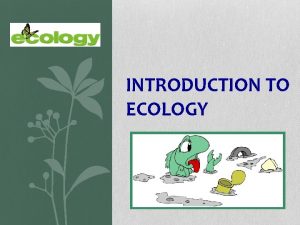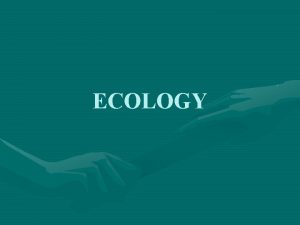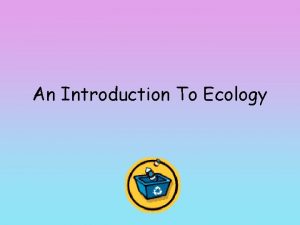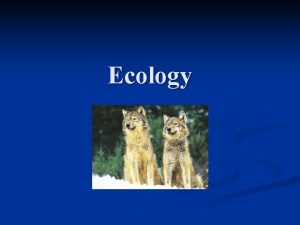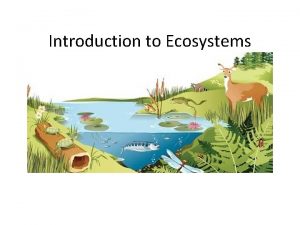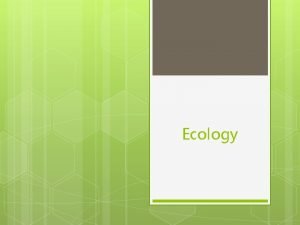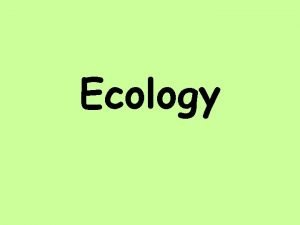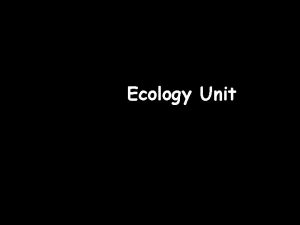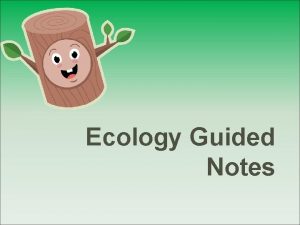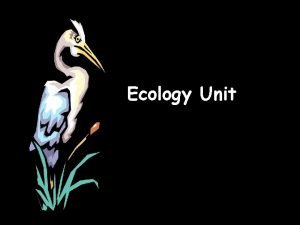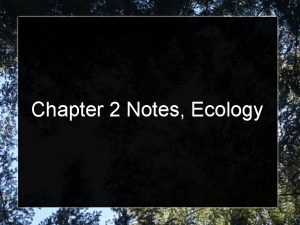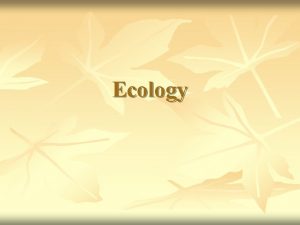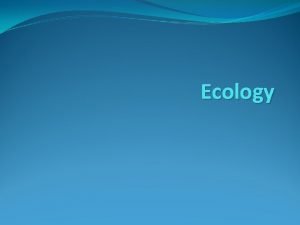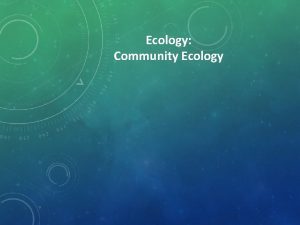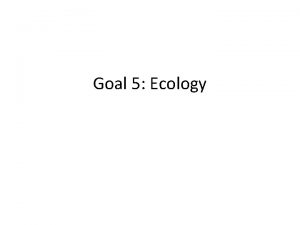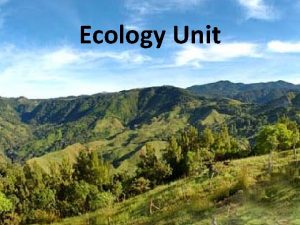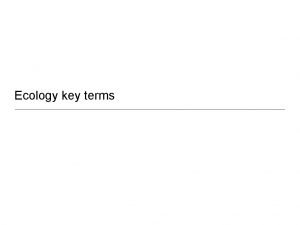INTRODUCTION TO ECOLOGY INTRODUCTION Ecology Ecology is the









































- Slides: 41

INTRODUCTION TO ECOLOGY

INTRODUCTION Ecology: Ecology is the scientific study of interactions among organisms with each other and their environment or surroundings. Biosphere The biosphere is the portion of the planet where life exists, including, land, water, air, or atmosphere.

Biotic and Abiotic Factors Bio = life Biotic factors are things that are living or were once living Examples: ? A = not Abiotic factors are things that were never alive Examples: ?

CHARACTERISTICS OF LIFE Organism= any individual living thing

BIOLOGY The science of “LIFE” =_________ = ________ Study of living things So what makes Something Alive? Image from: http: //analyzer. depaul. edu/astrobiology/kingdoms. jpg Bacteria

CHARACTERISTICS OF ALL LIVING THINGS cells 1. Made of _____ 2. Reproduce _______ universal genetic code 3. Based on a ___________ develop 4. Grow _______ and ______ Obtain & use materials & _______ energy 5. ______ Respond to their ______ environment 6. ____ change over time 7. As a group, _________

ALL LIVING THINGS ARE: MADE OF CELLS CELL is the The __________. basic unit of life http: //sps. k 12. ar. us/massengale/study_guides_bi. htm

ALL LIVING THINGS REPRODUCE SEXUAL REPRODUCTION ____________the combines genetic material __________ from _______ 2 parents ________ sperm + egg = baby Seen in animals and plants Family image from: http: //babyhearing. org/Parenet 2 Parent/index. asp

ALL LIVING THINGS REPRODUCE ASEXUAL REPRODUCTION _____________ makes a new organism using the genetic material ________ from ONLY 1 PARENT _________ Seen in bacteria, plants, and some animals Planaria animation: http: //www. t 3. rim. or. jp/~hylas/planaria/title. htm

All living things share a universal genetic code Hereditary material = DNA ___________ DEOXYRIBONUCLEIC ACID Segment of DNA with ________ PROTEIN instructions for one _____ GENE is called a ____. Image from: http: //sbchem. sunysb. edu/msl/dna. gif

ALL LIVING THINGS Grow & develop IMAGE BY RIEDELL SINGLE CELLED organisms, _______ like a bacterium, grow by INCREASING in SIZE ________.

ALL LIVING THINGS Grow & develop IMAGE BY RIEDELL Image from: http: //www. bcps. org/offices/lis/models/life/images/grow. JPG Multicellular organisms grow bigger increasing cell size by _________ AND ___________. increasing cell number

ALL LIVING THINGS Take in Materials & Use Energy grow and develop To________, organisms need _______ a constant supply of BUILDING MATERIALS & __________ ENERGY! ______ This sheep uses the MOLECULES and ENERGY in the food it eats to make “more sheep” http: //ag. ansc. purdue. edu/sheep/ansc 442/Semprojs/2003/spiderlamb/eatsheep. gif

ALL LIVING THINGS TAKE IN MATERIALS & USE ENERGY ______ use AUTOTROPHS energy from sunlight or chemicals to make their own food ________ Image from: http: //vilenski. org/science/safari/cellstructure/chloroplasts. html GREEN PLANTS use Ex: _______ photosynthesis ______to turn glucose _____ into _____ sunlight http: //www. inclusive. co. uk/downloads/images/pics 2/tree. gif

ALL LIVING THINGS TAKE IN MATERIALS & USE ENERGY _______ HETEROTROPHS get their energy by consuming other organisms __________ Animals (including you) Ex: ____ most bacteria and _________ Image from: http: //www. epa. gov/region 5/superfund/ecology/images/fishcartoon. gif

ALL LIVING THINGS RESPOND TO THEIR ENVIRONMENT A signal to which an organism responds STIMULUS = __________ Image from: http: //www. travel-net. com/~andrews/images/animations/traffic. gif

ALL LIVING THINGS RESPOND TO THEIR ENVIRONMENT Image from: http: //www. ccs. k 12. in. us/chs. BS/kons/images/stimresp. jpg A stimulus can be EXTERNAL _________ Ex: When there is enough water and ground is warm enough, seed germinates. Roots respond to gravity & grow downward. Leaves respond to sunlight & grow up. http: //www. nofretete-page. de/gemischt. Neu/TN_plant_grow_w. JPG

ALL LIVING THINGS RESPOND TO THEIR ENVIRONMENT http: //www. estrellamountain. edu/faculty/farabee/biobk/Bio. Book. CHEM 2. html A stimulus can be INTERNAL ______ Ex: When the glucose level in your bloodstream becomes low, your body responds by making you feel hungry. http: //www. israellycool. com/eat%20 guy%20 AFP. jpg

ALL LIVING THINGS AS A GROUP, CHANGE OVER TIME EVOLUTION = _______ Allows _______ survival of ____ in a species ______ changing world http: //cache. eb. com/eb/image? id=63386&rend. Type. Id=4

CFU 1. List three things that make something “living”? 2. Where do plants get their energy from if they don’t eat? 3. A virus is made of a protein shell (not an actual cell) and a small piece of genetic material. It can evolve and change over time. It can’t reproduce by itself or with another virus. It needs a host cell. Is a virus alive? Explain.

LEVELS OF ORGANIZATION Ecologists study different levels of organization to understand relationships within the biosphere. There are FIVE main levels of organization that ecologists study

LEVEL 1 – SPECIES Species – A group of organisms so similar to one another that they can breed and produce fertile offspring. Example: a porcupine, daisies, and red pandas are all different species

LEVEL 2 - POPULATION Population – A group of individuals that belong to the same species, live in the same area, and can interbreed. Example: These giraffes are members of a population

LEVEL 3 - COMMUNITY Community – All the populations that live together in a specific area Example: All of the living things that live in and around this stream live in the same community

LEVEL 4 - ECOSYSTEM Ecosystem – The community PLUS the abiotic factors in an area. Example: Grass, trees, insects, frogs, light, soil, sunlight, water

LEVEL 5 – BIOME Biome – A large area that has a particular climate and particular species of plants and animals that live there Example: Tropical rainforest (shown in dark green)

USE THE CHART TO SUMMARIZE YOUR INFORMATION Level 1 2 3 4 5 Name Example

CFU For each slide, write on a half sheet of paper what stage/level of system we are looking at. Be sure to look at the words AND pictures

RAINFORESTS

KOALAS IN AUSTRALIA

PENGUINS

ELEPHANT AND PLANTS

PEOPLE AND THEIR PETS

PLANTS, ANIMALS, SOIL, WATER

DESERT REGIONS

DEER IN ST LOUIS

FISH, WHALE, PLANTS, WATER

CLOUDS, CACTUS, SAND

TULIPS

COCKROACHES IN A DUMPSTER

PARROT AND TREE
 Hát kết hợp bộ gõ cơ thể
Hát kết hợp bộ gõ cơ thể Lp html
Lp html Bổ thể
Bổ thể Tỉ lệ cơ thể trẻ em
Tỉ lệ cơ thể trẻ em Gấu đi như thế nào
Gấu đi như thế nào Chụp phim tư thế worms-breton
Chụp phim tư thế worms-breton Alleluia hat len nguoi oi
Alleluia hat len nguoi oi Các môn thể thao bắt đầu bằng từ đua
Các môn thể thao bắt đầu bằng từ đua Thế nào là hệ số cao nhất
Thế nào là hệ số cao nhất Các châu lục và đại dương trên thế giới
Các châu lục và đại dương trên thế giới Cong thức tính động năng
Cong thức tính động năng Trời xanh đây là của chúng ta thể thơ
Trời xanh đây là của chúng ta thể thơ Cách giải mật thư tọa độ
Cách giải mật thư tọa độ Làm thế nào để 102-1=99
Làm thế nào để 102-1=99 độ dài liên kết
độ dài liên kết Các châu lục và đại dương trên thế giới
Các châu lục và đại dương trên thế giới Thể thơ truyền thống
Thể thơ truyền thống Quá trình desamine hóa có thể tạo ra
Quá trình desamine hóa có thể tạo ra Một số thể thơ truyền thống
Một số thể thơ truyền thống Cái miệng nó xinh thế chỉ nói điều hay thôi
Cái miệng nó xinh thế chỉ nói điều hay thôi Vẽ hình chiếu vuông góc của vật thể sau
Vẽ hình chiếu vuông góc của vật thể sau Thế nào là sự mỏi cơ
Thế nào là sự mỏi cơ đặc điểm cơ thể của người tối cổ
đặc điểm cơ thể của người tối cổ Ví dụ về giọng cùng tên
Ví dụ về giọng cùng tên Vẽ hình chiếu đứng bằng cạnh của vật thể
Vẽ hình chiếu đứng bằng cạnh của vật thể Fecboak
Fecboak Thẻ vin
Thẻ vin đại từ thay thế
đại từ thay thế điện thế nghỉ
điện thế nghỉ Tư thế ngồi viết
Tư thế ngồi viết Diễn thế sinh thái là
Diễn thế sinh thái là Dạng đột biến một nhiễm là
Dạng đột biến một nhiễm là So nguyen to
So nguyen to Tư thế ngồi viết
Tư thế ngồi viết Lời thề hippocrates
Lời thề hippocrates Thiếu nhi thế giới liên hoan
Thiếu nhi thế giới liên hoan ưu thế lai là gì
ưu thế lai là gì Hổ sinh sản vào mùa nào
Hổ sinh sản vào mùa nào Khi nào hổ mẹ dạy hổ con săn mồi
Khi nào hổ mẹ dạy hổ con săn mồi Hệ hô hấp
Hệ hô hấp Từ ngữ thể hiện lòng nhân hậu
Từ ngữ thể hiện lòng nhân hậu Thế nào là mạng điện lắp đặt kiểu nổi
Thế nào là mạng điện lắp đặt kiểu nổi











































